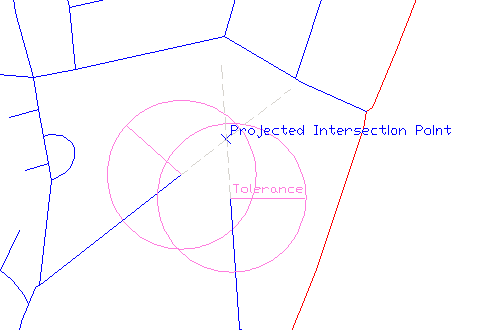Drawing Cleanup actions can be used to detect map errors (for example, duplicate objects, undershoots, or zero length objects), simplify complex 2D maps, and to weed and supplement 3D polylines. Because Drawing Cleanup can alter your data, make a backup of your data before cleaning up a map.
For best results, run cleanup actions individually or with a minimum of other actions.
The following table shows examples of problems that Drawing Cleanup can correct.
| Before Drawing Cleanup | After Drawing Cleanup | Description of Problem | Cleanup Action |
|---|---|---|---|
|
|
|
Duplicate objects | Delete Duplicates |
|
|
|
Short objects | Erase Short Objects |

|

|
Crossing objects | Break Crossing Objects |

|

|
Undershoots | Extend Undershoots |

|

|
Objects could be extended along their natural paths to intersect at a projected point | Apparent Intersection |

|

|
Node cluster | Snap Clustered Nodes |

|

|
Pseudo-nodes | Dissolve Pseudo-Nodes |

|

|
Dangles or overshoots | Erase Dangling Objects |

|

|
2D linear object simplification | Simplify Objects |
|
|
|
Zero-length objects | Zero-Length Objects. |

|

|
Too many or too few vertices in a 3D polyline | Weed Polylines |
Order of Cleanup Actions
The order of cleanup actions can produce different results. Specify the order by moving cleanup actions up or down in the list. The action at the top of the list is performed first.
Setting Cleanup Options
Set the options for each cleanup action individually. For more information, see the individual help topics about each cleanup action.
Cleaning for Topology
Some types of errors should be fixed before you create a topology. The following table indicates data errors that should be considered when you are creating a network or polygon topology. Node topologies do not usually require cleanup.
| Error | Network Topology | Polygon Topology |
|---|---|---|
| Duplicates | Must remove | Must remove |
| Short Linear Objects | Can remove | Can remove |
| Crossing Linear Objects | Check for validity. See To Create a Network Topology. | Must remove |
| Undershoots | Must remove | Must remove |
| Node Cluster | Must remove | Must remove |
| Pseudo Nodes | Can remove | Can remove |
| Dangles or overshoots | Check for validity. Can remove | Must remove |
| Simplify Linear Objects | Can apply | Can apply |
| Zero-Length Objects | Must remove | Must remove |
In addition, if you have closed polylines (polygons) that may be missing centroids, you should create centroids for them before using them in topology.
Notes
- Drawing Cleanup affects objects on layers that are OFF. It does not affect objects on layers that are FROZEN. It is recommended that you use drawing cleanup on a layer-by-layer basis, or on selective sets of layers. Avoid using automatic cleanup for all objects on all layers.
- All tools except Weed Polylines work in two dimensions only, ignoring Z-values. When you use the 2D tools, Z data (indicating elevations) might be lost when processing objects at different elevations.